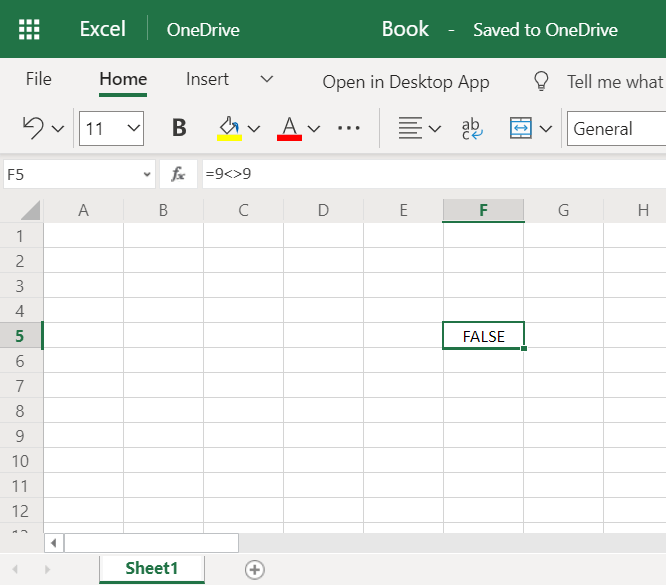

The COUNTIFS function below counts the number of cells in the range A1:A5 that are not equal to "red" and not equal to "blue".Įxplanation: the COUNTIFS function in Excel counts cells based on two or more criteria. The formula in cell C1 below returns TRUE because the text value in cell A1 is not equal to the text value in cell B1.
The & operator joins the 'not equal to' operator and the text value in cell C1.Ħ. The <> operator in Excel checks if two values are not equal to each other. The COUNTIF function below produces the exact same result. The <> operator in Excel checks if two values are not equal to each other.
The COUNTIF function below produces the exact same result. The <> operator in Excel checks if two values are not equal to each other. Note: visit our page about the COUNTIF function for more information about this Excel function.ĥ. The COUNTIF function below counts the number of cells in the range A1:A5 that are not equal to "red". Note: visit our page about the IF function for more information about this Excel function.Ĥ. The IF function below calculates the progress between a start and end value if the end value is not equal to an empty string (two double quotes with nothing in between), else it displays an empty string (see row 5). The formula in cell C1 below returns FALSE because the value in cell A1 is equal to the value in cell B1.ģ. If the result is FALSE, we return an empty string ("").2. If the result is TRUE, we multiply the original price by 1.1 (i.e. The test is the same as before (B6="red").

In that case, you can use a formula like this: =IF(C5="red",D5*1.1,"") It can be a cell reference or another formula. For example, let's say you want to increase the price of Red items only by 10%.
The result from IF does not need to be a hard-coded value. 1 Solver : add constraint 'not equal to' How add constraints of 'not equal to' when sign/relationship have only <,, >, Int, or Bin eg.If you need a case-sensitive formula, see the EXACT function.
#Excel not equal to how to#
In Excel, the symbol for not equal to is <>. ne and neq are the short codes for the does not equal sign within a Math Region in Word, PowerPoint and Excel (and Ill show you how to turn these on outside.The expressions below will all return TRUE: C5="Red" // returns TRUE We can use the Not equal to comparison operator in Excel to check if two values are not equal to each other. Note that Excel is not case-sensitive by default. If an empty string ("") is not provided for value_if_false, the IF function will return FALSE when the color is not "Red". The result returned by IF can be customized as needed. The final formula in cell F5 looks like this: =IF(C5="red","x","") Since we don't want to display anything when the color is not "Red", we provide an empty string (""), for the value to return if FALSE. Since we want to mark items when the color is "Red", we provide "x" for the value to return if TRUE: IF(C5="red","x", Next, we need to add a value when the result is TRUE and a value when the result is FALSE. The formula at this point looks like this: IF(C5="red", In cell F5, the result will be TRUE because C5 equals "red" but in cell F6 the result will be FALSE because C6 equals "Blue": C5="red" // returns TRUE This expression returns TRUE if the value in C5 is "red" and FALSE if not. In this formula, the logical test is this expression: C5="red" To accomplish this task, the formula in cell F5 is: =IF(C5="red","x","") In the worksheet shown, the goal is to identify rows where the color is "Red" by returning "x" as a marker. The result from IF can be a value, a cell reference, or even another formula. The generic syntax for IF looks like this: =IF(logical_test,if_true,if_false) The IF function runs a logical test and returns one value for a TRUE result, and another value for a FALSE result. From the Format Rules section, select Custom Formula and type in the formula. This means that it ignores the casing of the two text strings that are compared. Since you know the sum is 100, so to calculate What is not equal to 30 you can subtract. The Apply to Range section will already be filled in. The not equal to operator is case-insensitive. If you want to calculate a percentage of a number in Excel. Highlight the cells you wish to format, and then click on Format > Conditional Formatting. Its a combination of the Less Than and Greater Than. The most common way to solve this problem is with the IF function. The process to highlight cells that do not equal a specific number in Google Sheets is similar to the process in Excel. It checks if two values are not equal and returns TRUE or FALSE. How do I write a 'not equal to' condition where a number should be interpreted as text Ask Question Asked 2 years, 10 months ago Modified 1 year ago Viewed 644 times 0 I have two columns in my Excel-sheet, we can call them A and B. The goal is to do something if a cell equals a given value.


 0 kommentar(er)
0 kommentar(er)
